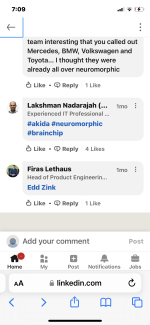Fullmoonfever
Top 20
Pretty sure I saw someone posted something on Socionext not long ago but tried searching to make sure not duplicated post but can't find it.
Anyway, nice page and you'd surmise that the products contained on the same page as the BRN spiel would have something to do with Akida.

 socionextus.com
socionextus.com
Socionext’s advanced custom solutions are designed to help OEMs and tier-one automakers achieve complete ownership of key differentiating technologies with an added competitive edge.
These custom SoCs enable a wide range of applications, including ADAS sensors, central computing, networking, in-cabin monitoring, satellite connectivity, and infotainment.


The Socionext 60GHz RF CMOS sensor has features and capabilities to support multiple in-cabin uses, including seat occupancy monitoring, child presence detection, and theft prevention
BrainChip’s flexible AI processing fabric IP delivers neuromorphic, event-based computation, enabling ultimate performance while minimizing silicon footprint and power consumption. Sensor data can be analyzed in real-time with distributed, high-performance and low-power edge inferencing, resulting in improved response time and reduced energy consumption.
Anyway, nice page and you'd surmise that the products contained on the same page as the BRN spiel would have something to do with Akida.

Automotive Custom SoC Technologies and Solutions
Socionext’s advanced automotive custom SoC solutions are designed to help OEMs and tier-one automakers achieve differentiating technologies
Automotive Custom SoC Technologies and Solutions
Featuring advanced technologies in automotive display, AI, and smart sensing
Socionext’s advanced custom solutions are designed to help OEMs and tier-one automakers achieve complete ownership of key differentiating technologies with an added competitive edge.
These custom SoCs enable a wide range of applications, including ADAS sensors, central computing, networking, in-cabin monitoring, satellite connectivity, and infotainment.

Key Strengths:
- Leading Edge Process Technology
- Mixed Signal IP & SoC Development
- RF-CMOS Design & Integration
- High-Performance CPU Platform Design
- High-Speed Interface IP Development
- Advance Packaging Technology, Low power, high speed, and large-scale design expertise
Design and Development:
- High core count CPU subsystem development
- Safety Island, System Management, and Secure Boot
- High Performance interconnect (NIC/NOC)
- ISP, GPU & NNA acceleration for power/performance optimization
- High-speed interfaces for chip-to-chip communication
- High-speed networking & peripheral interfaces
- Integrated user hardware function for product differentiation
- High bandwidth memory interfaces
- Emulation & prototyping for reduced development time, early performance evaluation & early software development

Smart Display Controller for Automotive Remote Display
Socionext's highly integrated ISO26262-certified SC1721/ SC1722/ SC1723 Series Graphics Display Controllers feature built-in safety mechanisms that enable error-free, safety-critical content to meet the safety standards required by today’s multi-display cockpit applications.Collateral
- Indigo Graphics Display Controller Signature Units
- Indigo3-X Smart Cluster Demonstrator
- Graphic Display Controllers: SC172x Series
- Indigo4 Presentation
Low Power 60GHz RF CMOS Radar Sensors with Embedded Sensing Engine and Built-in Antenna for In-Cabin Monitoring
Socionext has created a variety of smart RADAR solutions, including 24GHz and 60GHz, and has developed a roadmap showcasing future technologies.The Socionext 60GHz RF CMOS sensor has features and capabilities to support multiple in-cabin uses, including seat occupancy monitoring, child presence detection, and theft prevention
Collateral
Advanced AI Solutions for Automotive
Socionext has partnered with artificial intelligence provider BrainChip to develop optimized, intelligent sensor data solutions based on Brainchip’s Akida® processor IP.BrainChip’s flexible AI processing fabric IP delivers neuromorphic, event-based computation, enabling ultimate performance while minimizing silicon footprint and power consumption. Sensor data can be analyzed in real-time with distributed, high-performance and low-power edge inferencing, resulting in improved response time and reduced energy consumption.


